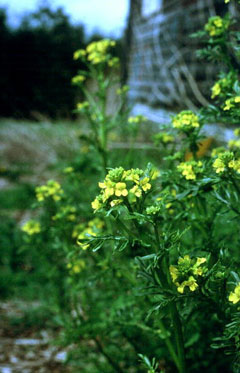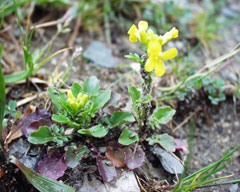 |
|
(c) 2010 Ken Fern & Plants For A Future |
 |
| http://fr.wikipedia.org/wiki/Projet:Botanique/Accord_Henry_Brisse |
Translate this page:
Summary
Physical Characteristics

 Barbarea verna is a BIENNIAL growing to 0.3 m (1ft) by 0.3 m (1ft in).
Barbarea verna is a BIENNIAL growing to 0.3 m (1ft) by 0.3 m (1ft in).
See above for USDA hardiness. It is hardy to UK zone 6 and is not frost tender. It is in flower from May to July, and the seeds ripen from June to August. The species is hermaphrodite (has both male and female organs) and is pollinated by Flies, bees, beetles. The plant is self-fertile.
Suitable for: light (sandy), medium (loamy) and heavy (clay) soils and prefers well-drained soil. Suitable pH: mildly acid, neutral and basic (mildly alkaline) soils. It can grow in full shade (deep woodland) semi-shade (light woodland) or no shade. It prefers moist soil.
UK Hardiness Map
US Hardiness Map
Synonyms
B. praecox. (Sm.)R.Br. Campe verna.
Plant Habitats
Woodland Garden Sunny Edge; Dappled Shade; Shady Edge; not Deep Shade; North Wall. By.
Edible Uses
Edible Parts: Leaves Oil Seed
Edible Uses: Oil
Young leaves - raw, cooked or used as a seasoning[1, 2, 33, 37, 52]. A hot, spicy watercress flavour, they are delicious in salads[183, 244]. Leaves can be obtained throughout the year if autumn-sown plants are given a light protection in winter[1]. An edible oil is obtained from the seed[46, 52, 61, 183]. The seed can be sprouted and added to salads etc[183].
References More on Edible Uses
Medicinal Uses
Plants For A Future can not take any responsibility for any adverse effects from the use of plants. Always seek advice from a professional before using a plant medicinally.
None known
References More on Medicinal Uses
The Bookshop: Edible Plant Books
Our Latest books on Perennial Plants For Food Forests and Permaculture Gardens in paperback or digital formats.

Edible Tropical Plants
Food Forest Plants for Hotter Conditions: 250+ Plants For Tropical Food Forests & Permaculture Gardens.
More

Edible Temperate Plants
Plants for Your Food Forest: 500 Plants for Temperate Food Forests & Permaculture Gardens.
More

More Books
PFAF have eight books available in paperback and digital formats. Browse the shop for more information.
Shop Now
Other Uses
References More on Other Uses
Cultivation details
Succeeds in sun or shade in a moist well-drained soil,[200] growing well on a north facing wall[33, 52]. The summer crop is best if it is given some shade whilst the winter crop succeeds in sunny positions[1, 200]. Land cress is often cultivated as a salad plant, when it is usually treated as an annual[46]. It can supply leaves all year round from successional sowings[1]. In hot weather plants soon run to seed unless they are kept shaded and moist[183]. The leaves taste much hotter in the summer[K]. Plants usually self-sow freely when growing in a suitable position[K].
References Carbon Farming Information and Carbon Sequestration Information
Temperature Converter
Type a value in the Celsius field to convert the value to Fahrenheit:
Fahrenheit:
The PFAF Bookshop
Plants For A Future have a number of books available in paperback and digital form. Book titles include Edible Plants, Edible Perennials, Edible Trees,Edible Shrubs, Woodland Gardening, and Temperate Food Forest Plants. Our new book is Food Forest Plants For Hotter Conditions (Tropical and Sub-Tropical).
Shop Now
Plant Propagation
Seed - sow spring to September in situ at 3-weekly intervals to provide a succession of leaves. Germination usually takes place within 2 - 3 weeks.
Other Names
If available other names are mentioned here
Native Plant Search
Search over 900 plants ideal for food forests and permaculture gardens. Filter to search native plants to your area. The plants selected are the plants in our book 'Plants For Your Food Forest: 500 Plants for Temperate Food Forests and Permaculture Gardens, as well as plants chosen for our forthcoming related books for Tropical/Hot Wet Climates and Mediterranean/Hot Dry Climates. Native Plant Search
Found In
Countries where the plant has been found are listed here if the information is available
Weed Potential
Right plant wrong place. We are currently updating this section.
Please note that a plant may be invasive in one area but may not in your area so it’s worth checking.
Conservation Status
IUCN Red List of Threatened Plants Status :

Growth: S = slow M = medium F = fast. Soil: L = light (sandy) M = medium H = heavy (clay). pH: A = acid N = neutral B = basic (alkaline). Shade: F = full shade S = semi-shade N = no shade. Moisture: D = dry M = Moist We = wet Wa = water.

Expert comment
Author
(Mill.)Asch.
Botanical References
200
Links / References
For a list of references used on this page please go here
Readers comment
© 2010, Plants For A Future. Plants For A Future is a charitable company limited by guarantee, registered in England and Wales. Charity No. 1057719, Company No. 3204567.